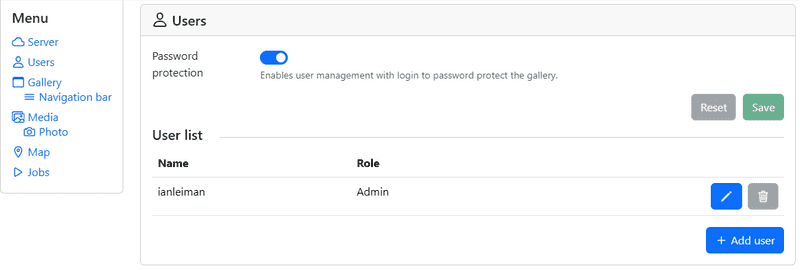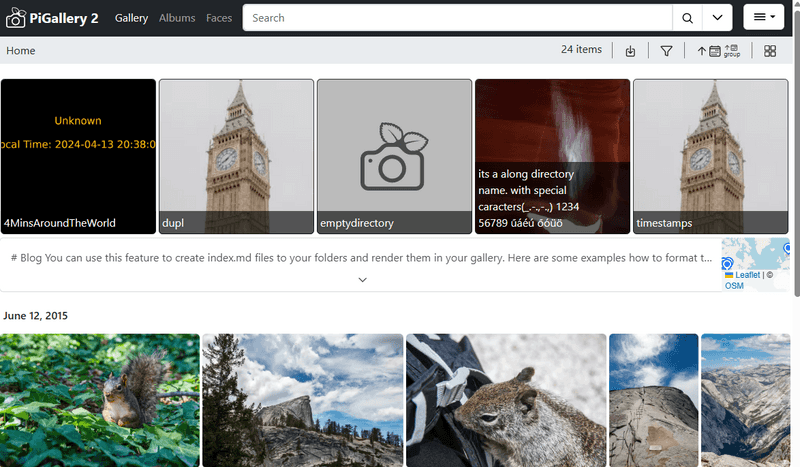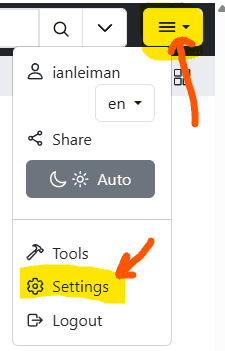Introduction
In this tutorial, we'll deploy a PiGallery2 photo gallery application on a Hetzner cloud server.
PiGallery2 is a fast (like faster than your PC fast) directory-first photo gallery website, optimised for running on low resource servers, especially on Raspberry Pi, but it will be lightning fast even on a low end Hetzner cloud server such as CX23.
A live demo can be seen at pigallery2.onrender.com
PiGallery2 is open source and free for personal use. PiGallery2 is implemented in TypeScript language, and it has a backend that runs on node.js server, and a fluent Single Page Application (SPA) Web Graphical User interface based on JavaScript. There is active development and a big supporting community.
By the end of this tutorial, you'll have a working PiGallery2 photo gallery application deployed on your own server with automatic HTTPS. PiGallery2 is deployed here on a basic Ubuntu Linux system, which should have Apache and node.js installed. PiGallery2 will run on node.js server on port 3000 as system service, and Apache reverse proxy makes the server securely available to the public Internet.
Prerequisites
To run PiGallery you need to have the following prerequisites. Setting these up is not in scope of this tutorial as there are other tutorials available for this.
- A server with Ubuntu 24.04 and at least 4GB RAM
A Hetzner cloud server such as CX23 is a good choice for running PiGallery. CX23 will have enough performance to additionally run many other lightweight web services in parallel. You can use the LAMP stack image to get a working Ubuntu and Apache out of the box. Note that PHP and MySQL are not required for PiGallery but may be useful for running other services in the same server.
- sudo privilege
- Apache web server and node.js already installed
sudo apt install nodejs apache2 apache2 -v && nodejs -v - certbot already installed for Let's Encrypt HTTPS
- A domain name you can configure
- Last but not least: you should have some media files on your server. For testing purposes, you can download an image by running:
mkdir -p "$HOME/mediafiles" wget -O "$HOME/mediafiles/image.png" https://picsum.photos/200
Example terminology
- Domain:
example.com - Server public:
203.0.113.1 - User name:
holu - Media directory:
/home/holu/mediafiles
Step 0 - Preparing the media files
PiGallery supports viewing JPEG, WebP, PNG, SVG, MP4, OGG, OGV, WebM media files. It can easily show 100K files in a directory hierarchy.
It can access any media directory mounted on your server for which it has read access. Unlike many other web media galleries, the media is not stored to any database. You can simply copy your media to any directory accessible to your server. You can use any methods of your choice to manage those files such as FTP or SCP.
If you use a server like the Hetzner cloud server plan CX23, you will have 40 GB NVME storage out of box, out of which about 30 GB you could dedicate to media files. If that is not enough, then you can easily extend that up to 10TB with block storage volumes.
PiGallery shows your media in directory hierarchy. It is a good practice to organize your media files into a directory hierarchy by a topics or categories, where each directory has no more than 100 files or sub-directories.
In this tutorial we assume that your media files are located in a
directory /home/holu/mediafiles
Step 1 - Installing nvm and node
PiGallery2 requires node version 22. It is best to install node using Node Version Manager nvm, which we will install first, and then node and npm, specifically version 22. The latest 24 is too new.
# install nvm
sudo curl -o- https://raw.githubusercontent.com/nvm-sh/nvm/v0.39.7/install.sh | bash
source ~/.bashrc
# optional: list available versions
nvm ls-remote
# install node 22
nvm install 22
nvm use 22
nvm alias default 22
# verify versions
node -v
npm -vWe also install ffmpeg, that is required for video processing.
sudo apt install ffmpegStep 2 - Installing PiGallery
At the time of writing, PiGallery release 3.0.1 is the latest one, released November 2025. A
release zip package is available at GitHub , see: github.com/bpatrik/pigallery2/release
Here we use wget to download the zip which we then unzip to a directory
/home/holu/pigallery/rel300. You can chose some other
directory of course.
mkdir $HOME/pigallery
cd $HOME/pigallery
wget https://github.com/bpatrik/pigallery2/releases/download/3.0.1/pigallery2-release.zip
unzip pigallery2-release.zip -d rel300Now we are ready to run the npm install, which will fetch all required node packages automatically.
Note that you need to have nodejs, npm, ffmpeg installed already
cd rel300
npm installNow you are ready to test that it works
mkdir -p $HOME/pigallery/rel300/demo/tmp
npm start -- --Server-port=3000This will fire up PiGallery on localhost port 3000. Assuming your server
has the IP address 203.0.113.1, you should now be able to see
PiGallery running at http://203.0.113.1:3000. You can choose some
other port number of course. Note that ports numbered 1024 and
higher do not require root access to use, and ports below 1024 are
considered privileged and do require root privilege.
This will work only if you have configured your server to allow access port 3000 externally. Or the other way around, you have not blocked port 3000 access with a firewall for example. At a later section, this tutorial will show how to harden your server for better security.
After launching PiGallery this way, you can stop it running via ctrl+c in the
terminal. Or if you leave terminal open, it will eventually time out and
kill the child process PiGallery. A later section explains how you can
make PiGallery a system service that runs always.
Step 3 - Configuring PiGallery on first run
On first run, PiGallery creates a config.json file, which contains the
application configuration. config.json can be edited manually but it is
better to use the UI to configure. To find the configuration after logging into the UI:
- Click on the hamburger menu in the top right corner
- Select "Settings"
On first run, also a SQLite database is created to store persistent data used by the application.
The default Admin account on first run is:
- user:
admin - pass:
admin
You should change this immediately. Login as admin/admin and then go to settings:
-
In Users, click
Add User, give a name other than admin, role Admin and a good password. -
Once a new Admin-level user added, log out
-
log in with your new Admin-level user credentials
-
open settings
-
In Users: click the trash can to remove the default admin/admin account
-
log out again, and login again
-
now confirm that the default admin/admin account is gone
You can add other accounts too, and it is recommended to add User and
Guest level accounts. Note that the passwords are stored encrypted.

location of your media gallery
The next important thing to configure is the location of your media
gallery. Assuming your media files are located in
/home/holu/mediafiles and PiGallery is installed at
/home/holu/pigallery/rel300, use following commands to
link them. Make sure that you have read access for all of the media
files and directories.
cd $HOME/pigallery/rel300
ln -s $HOME/mediafiles MEDIAIn PiGallery settings, Media, enter to Image Folder: MEDIA. Then
click Save. Click on top menu Gallery to view your media.

Full list of configuration options are available at the MANPAGE.md.
Step 4 - Configuring PiGallery systemd service
Now we configure PiGallery as a systemd service so that it runs 24/7. This requires sudo privilege.
First we ned to know what the full path to node version 22 is, because
PiGallery needs exactly this version. If you installed node using nvm as
in previous steps and set version 22 as default, then you can use
which node command to see the path.
which node
/home/holu/.nvm/versions/node/v22.21.1/bin/nodeIn case your system default is some other version, then use nvm which 22
nvm which 22
/home/holu/.nvm/versions/node/v22.21.1/bin/nodeThen we need to edit a file named
/lib/systemd/system/pigallery.service.
sudo nano "/lib/systemd/system/pigallery.service"Below is an example /lib/systemd/system/pigallery.service, with
following configuration.
-
use server port 3000 (you can change this)
-
run node in production mode (you can also
developmentfor troubleshooting) -
PiGallery is to run as user
holu -
PiGallery is installed at
/home/holu/pigallery2/rel300/ -
node version 22 is at
/home/holu/.nvm/versions/node/v22.21.1/bin/node
[Unit]
Description=PiGallery 3.0.1 photo gallery
After=network-online.target
[Service]
Environment="NODE_ENV=production"
Environment="PORT=3000"
Restart=on-failure
User=holu
WorkingDirectory=/home/holu/pigallery/rel300/
ExecStart=/home/holu/.nvm/versions/node/v22.21.1/bin/node /home/holu/pigallery/rel300/src/backend/index.js
[Install]
WantedBy=multi-user.targetNow that the pigallery.service file is in place, you can run commands to load the
configuration and (re)start the service pigallery.
sudo systemctl daemon-reload
sudo systemctl restart pigallery
sudo systemctl status pigallery
# If it works, enable, do a reboot
sudo systemctl enable pigallery
sudo reboot
# After reboot, check status
sudo systemctl status pigalleryIf it started ok, then you should see PiGallery running at:
http://<serverip>:3000Troubleshooting
If PiGallery did not start, then following command will show error messages:
sudo journalctl -lf -u pigalleryThe most common problem is that the node version is wrong, node package
installations have failed, or npm install was a fail.
Some useful commands
Following commands can be used to stop, restart, reload the service and debug problems.
sudo systemctl daemon-reload # reload configuration changes
sudo systemctl stop pigallery # stop the service
sudo systemctl restart pigallery # start the service
sudo systemctl disable pigallery # disable
sudo systemctl enable pigallery # enable
cat /lib/systemd/system/pigallery.service # check the configuration
sudo nano /lib/systemd/system/pigallery.service # edit the configuration
lsof -i:3000 # check port 3000
ps -efl | grep "port=3000" # processes related to port 3000
sudo journalctl -lf -u pigallery # journalStep 5 - Configuring Apache and reverse proxy
Now PiGallery is running at port 3000 as http://<serverip>:3000,
but it is more convenient and secure if you could access it like
https://mygallery.example.com. This can be done assigning your
server's IP address to a domain name like mygallery.example.com and
then configuring Apache web server to proxy that domain name to port
3000.
How to configure DNS records to your server is not in scope of this
tutorial as there are other tutorials covering that. Following
instructions assume that you have configured mygallery.example.com
to point at your server's IP address.
Test setup
It is a good practice to first test a new Apache virtual host with plain HTML service before going to a proxy service. You can skip this step if you are confident that your Apache surely works.
Create a file named mygallery.example.com.conf in
/etc/apache2/sites-available/:
sudo nano /etc/apache2/sites-available/mygallery.example.com.confPaste the following into the file:
<VirtualHost *:80>
ServerName mygallery.example.com
ServerAlias www.mygallery.example.com
DocumentRoot /var/www/mygallery
<Directory /var/www/mygallery>
Options Indexes FollowSymLinks
AllowOverride All
Require all granted
</Directory>
ErrorLog ${APACHE_LOG_DIR}/mygallery_error.log
CustomLog ${APACHE_LOG_DIR}/mygallery_access.log combined
</VirtualHost>Create the Document Root
sudo mkdir -p /var/www/mygallery
sudo chown -R $USER:$USER /var/www/mygalleryAdd a simple index.html to test:
echo "<h1>Welcome to MyGallery</h1>" | sudo tee /var/www/mygallery/index.htmlEnable the Site and Restart Apache
sudo a2ensite mygallery.example.com.conf
sudo systemctl reload apache2Now at http://mygallery.example.com you should your index.html
Enable HTTPS
Most browsers will complain about your site being unsecure unless you have HTTPS enabled.
Following instructions assume you will use Let's Encrypt with the certbot tool. If you do not have certbot already, then following commands will install it for you. Skip this if you already have certbot:
sudo apt update
sudo apt install certbot python3-certbot-apacheRun this command to automatically configure HTTPS for your site
sudo certbot --apache -d mygallery.example.comLet's Encrypt certificates expire every 90 days. Certbot sets up a cron job or systemd timer to renew them automatically. You can test it with:
sudo certbot renew --dry-runVisit https://mygallery.example.com in your browser. You should see a secure connection with padlock icon.
Certbot has created a new file
/etc/apache2/sites-available/mygallery.example.com-le-ssl.conf.
At the beginning of that file you see virtual server for port 443 that is the HTTPS port and Apache mod_ssl module is enabled for SSH.
<IfModule mod_ssl.c>
<VirtualHost *:443>Then at the ned of the file there are the paths to SSL certificates for this site
SSLCertificateFile /etc/letsencrypt/live/mygallery.example.com /fullchain.pem
SSLCertificateKeyFile /etc/letsencrypt/live/mygallery.example.com /privkey.pem
Include /etc/letsencrypt/options-ssl-apache.confThen new lines are added at end of
/etc/apache2/sites-available/mygallery.example.com.conf that will
redirect HTTP requests to the HTTPS to prevent unsecure access.
RewriteEngine on
RewriteCond %{SERVER_NAME} = mygallery.example.com
RewriteRule ^ https://%{SERVER_NAME}%{REQUEST_URI} [END,NE,R=permanent]This information is needed for the next step.
Proxy configuration
Finally we change mygallery.example.com to connect to the PiGallery
service running on localhost port 3000.
-
First you need to enable Apache proxy modules and restart Apache.
sudo a2enmod proxy sudo a2enmod proxy_http sudo systemctl restart apache2 -
Then modify
/etc/apache2/sites-available/mygallery.example.com.conf# site mygallery.example.com # which is PiGallery2 nodejs app on port 3000 <VirtualHost *:80> ServerName mygallery.example.com ServerAlias www.mygallery.tests.example.com ProxyPreserveHost On AllowEncodedSlashes On ProxyPass / http://localhost:3000/ ProxyPassReverse / http://localhost:3000/ <Proxy *> Require all granted Options None </Proxy> ErrorLog ${APACHE_LOG_DIR}/mygallery_error.log CustomLog ${APACHE_LOG_DIR}/mygallery_access.log combined RewriteEngine on RewriteCond %{SERVER_NAME} = mygallery.example.com RewriteRule ^ https://%{SERVER_NAME}%{REQUEST_URI} [END,NE,R=permanent] </VirtualHost> -
Modify
/etc/apache2/sites-available/mygallery.example.com-le-ssl.conf# site mygallery.example.com # which is PiGallery2 nodejs app on port 3000 <IfModule mod_ssl.c> <VirtualHost *:443> ServerName mygallery.example.com ServerAlias www.mygallery.example.com ProxyPreserveHost On AllowEncodedSlashes On ProxyPass / http://localhost:3000/ ProxyPassReverse / http://localhost:3000/ <Proxy *> Require all granted Options None </Proxy> ErrorLog ${APACHE_LOG_DIR}/mygallery_error.log CustomLog ${APACHE_LOG_DIR}/mygallery_access.log combined SSLCertificateFile /etc/letsencrypt/live/mygallery.example.com /fullchain.pem SSLCertificateKeyFile /etc/letsencrypt/live/mygallery.example.com /privkey.pem Include /etc/letsencrypt/options-ssl-apache.conf </VirtualHost> -
Now restart Apache
sudo systemctl restart apache2
Visit https://mygallery.example.com to verify that PiGallery is now
accessible and running as expected. Now you have your media gallery
online.
Step 6 - Final touches
Log into PiGallery and go to:
- Settings » Server
Add the following information:
| Option | Content |
|---|---|
| Public URL | https://mygallery.example.com |
| Page title | "My amazing PiGallery" or something like it |
Full list of configuration options are available at the MANPAGE.md. There are a lot of things you can configure. Many languages are supported.
Server logs
The file \${APACHE_LOG_DIR}/mygallery_access.log will contain an
access log to your PiGallery.
You can view it for example like this:
source /etc/apache2/envvars
sudo less $APACHE_LOG_DIR/mygallery_access.logStep 7 - Hardening your server (Optional)
It is recommended to harden your server for better security by blocking access to all ports that are not in service. Certainly port 3000 should not be accessible for everyone. Following example shows how to block access to all ports except SSH (22), HTTP (80), and HTTPS (443) using ufw (Uncomplicated Firewall).
sudo ufw allow 22/tcp # SSH
sudo ufw allow 80/tcp # HTTP
sudo ufw allow 443/tcp # HTTPS
sudo ufw default deny incoming
sudo ufw default allow outgoing
sudo ufw default allow outgoing
sudo ufw enableBut maybe you want to keep port 3000 open for your own testing? A secure
way to do this is to enable port 3000 access to an IP-address that only
you can use, let's say it is 198.51.100.1. Following command does
the trick:
sudo ufw allow from 198.51.100.1 to any port 3000 proto tcpHardening your server this way prevents hackers to cause undue load to your server and lessen the effect of denial-of-service attacks.
Conclusion
You should now have a running PiGallery instance.

